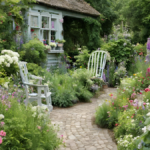Creating a Zen garden is a transformative journey that brings tranquility, balance, and simplicity to your outdoor space. Rooted in Japanese tradition, Zen gardens are renowned for their minimalist design, harmonious elements, and meditative atmosphere. Let’s explore the key principles and practical tips to guide you in crafting your own Zen garden.
Embracing Minimalism:
Zen gardens are a celebration of simplicity. Begin by decluttering your space and opting for a minimalist approach in both design and plant selection. Choose a few essential elements and allow them to shine in their unadorned beauty.
Selecting the Right Location:
Choose a quiet and contemplative spot for your Zen garden. Whether it’s a corner of your backyard, a small courtyard, or a dedicated space within a larger garden, the key is to create an area that encourages mindfulness and serenity.
Essential Elements:
- Gravel or Sand:
- The foundation of many Zen gardens is gravel or sand raked into patterns that represent flowing water. The act of raking induces a meditative state and imparts a sense of movement to the garden.
- Large Rocks or Boulders:
- Introduce large rocks or boulders strategically to represent mountains or islands. These natural elements add a sense of permanence and grounding to the garden.
- Pruned Trees and Shrubs:
- Select trees and shrubs that can be pruned into clean and geometric shapes. Common choices include Japanese maple, pine, or boxwood. Pruning not only maintains the garden’s aesthetic but also symbolizes order and control.
- Zen Garden Bridge:
- If space allows, consider adding a small wooden bridge. This simple yet elegant structure adds an architectural element and enhances the symbolic flow of the garden.
- Moss and Ground Cover:
- Encourage the growth of moss or low-maintenance ground cover to create a lush and green carpet. This adds softness to the overall design and complements the harder elements like rocks and gravel.
Symbolic Arrangement:
Zen gardens often incorporate symbolic arrangements to evoke contemplation and reflection. Consider placing rocks in groups of three or five, as odd numbers are believed to be more harmonious. Experiment with different rock formations and observe how they interact with the surrounding elements.
Raking Techniques:
The rhythmic act of raking the gravel or sand is not just a practical aspect but also a meditative practice. Experiment with different rake patterns, such as concentric circles or straight lines, to find what resonates with you. The act of raking is a form of moving meditation, promoting mindfulness and focus.
Adding Personal Touches:
While Zen gardens traditionally adhere to a restrained palette, feel free to add personal touches that bring meaning to your space. Consider incorporating a stone lantern, bamboo water feature, or a small meditation bench for moments of reflection.
Maintenance:
Regular maintenance is essential to keep your Zen garden pristine. Rake the gravel or sand regularly to maintain the patterns and remove any debris. Prune plants as needed to preserve their clean and geometric shapes. The act of tending to your Zen garden becomes part of the meditative experience.
In conclusion, creating a Zen garden is not just about design; it’s a mindful journey that brings balance and peace to your outdoor space. By embracing simplicity, incorporating natural elements, and engaging in meditative practices like raking, you can cultivate a haven of serenity in your own backyard. Allow your Zen garden to become a place of refuge, inviting moments of contemplation and tranquility into your daily life.



